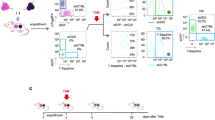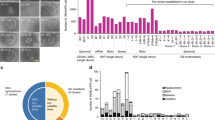Abstract
Insertional mutagenesis represents a major hurdle to gene therapy and necessitates sensitive preclinical genotoxicity assays. Cdkn2a−/− mice are susceptible to a broad range of cancer-triggering genetic lesions. We exploited hematopoietic stem cells from these tumor-prone mice to assess the oncogenicity of prototypical retroviral and lentiviral vectors. We transduced hematopoietic stem cells in matched clinically relevant conditions, and compared integration site selection and tumor development in transplanted mice. Retroviral vectors triggered dose-dependent acceleration of tumor onset contingent on long terminal repeat activity. Insertions at oncogenes and cell-cycle genes were enriched in early-onset tumors, indicating cooperation in tumorigenesis. In contrast, tumorigenesis was unaffected by lentiviral vectors and did not enrich for specific integrants, despite the higher integration load and robust expression of lentiviral vectors in all hematopoietic lineages. Our results validate a much-needed platform to assess vector safety and provide direct evidence that prototypical lentiviral vectors have low oncogenic potential, highlighting a major rationale for application to gene therapy.
This is a preview of subscription content, access via your institution
Access options
Subscribe to this journal
Receive 12 print issues and online access
$209.00 per year
only $17.42 per issue
Buy this article
- Purchase on Springer Link
- Instant access to full article PDF
Prices may be subject to local taxes which are calculated during checkout





Similar content being viewed by others
References
Schroder, A. et al. HIV-1 integration in the human genome favors active genes and local hotspots. Cell 110, 521–529 (2002).
Wu, X., Li, Y., Crise, B. & Burgess, S.M. Transcription start regions in the human genome are favored targets for MLV integration. Science 300, 1749–1751 (2003).
Mitchell, R.S. et al. Retroviral DNA integration: ASLV, HIV, and MLV show distinct target site preferences. PLoS Biol. 2, E234 (2004).
Hematti, P. et al. Distinct genomic integration of MLV and SIV vectors in primate hematopoietic stem and progenitor cells. PLoS Biol. 2, e423 (2004).
De Palma, M. et al. Promoter trapping reveals significant differences in integration site selection between MLV and HIV vectors in primary hematopoietic cells. Blood 105, 2307–2315 (2005).
Nakai, H. et al. AAV serotype 2 vectors preferentially integrate into active genes in mice. Nat. Genet. 34, 297–302 (2003).
Kohn, D.B. et al. T lymphocytes with a normal ADA gene accumulate after transplantation of transduced autologous umbilical cord blood CD34+ cells in ADA-deficient SCID neonates. Nat. Med. 4, 775–780 (1998).
Malech, H.L. et al. Prolonged production of NADPH oxidase-corrected granulocytes after gene therapy of chronic granulomatous disease. Proc. Natl. Acad. Sci. USA 94, 12133–12138 (1997).
Aiuti, A. et al. Correction of ADA-SCID by stem cell gene therapy combined with nonmyeloablative conditioning. Science 296, 2410–2413 (2002).
Cavazzana-Calvo, M., Lagresle, C., Hacein-Bey-Abina, S. & Fischer, A. Gene therapy for severe combined immunodeficiency. Annu. Rev. Med. 56, 585–602 (2005).
Gaspar, H.B. et al. Gene therapy of X-linked severe combined immunodeficiency by use of a pseudotyped gammaretroviral vector. Lancet 364, 2181–2187 (2004).
Bordignon, C. & Roncarolo, M.G. Therapeutic applications for hematopoietic stem cell gene transfer. Nat. Immunol. 3, 318–321 (2002).
Hacein-Bey-Abina, S. et al. LMO2-associated clonal T cell proliferation in two patients after gene therapy for SCID-X1. Science 302, 415–419 (2003).
Coffin, J., Hughes, S.H. & Varmus, H.E. Retroviruses (Cold Spring Harbor Laboratory Press, Plainview, 2000).
Lund, A.H. et al. Genome-wide retroviral insertional tagging of genes involved in cancer in Cdkn2a-deficient mice. Nat. Genet. 32, 160–165 (2002).
Suzuki, T. et al. New genes involved in cancer identified by retroviral tagging. Nat. Genet. 32, 166–174 (2002).
Mikkers, H. et al. High-throughput retroviral tagging to identify components of specific signaling pathways in cancer. Nat. Genet. 32, 153–159 (2002).
Mikkers, H. & Berns, A. Retroviral insertional mutagenesis: tagging cancer pathways. Adv. Cancer Res. 88, 53–99 (2003).
Akagi, K., Suzuki, T., Stephens, R.M., Jenkins, N.A. & Copeland, N.G. RTCGD: retroviral tagged cancer gene database. Nucleic Acids Res. 32 Database issue, D523–527 (2004).
Dupuy, A.J., Akagi, K., Largaespada, D.A., Copeland, N.G. & Jenkins, N.A. Mammalian mutagenesis using a highly mobile somatic Sleeping Beauty transposon system. Nature 436, 221–226 (2005).
Du, Y., Spence, S.E., Jenkins, N.A. & Copeland, N.G. Cooperating cancer gene identification via oncogenic retrovirus-induced insertional mutagenesis. Blood 106, 2498–2505 (2005).
Collier, L.S., Carlson, C.M., Ravimohan, S., Dupuy, A.J. & Largaespada, D.A. Cancer gene discovery in solid tumours using transposon-based somatic mutagenesis in the mouse. Nature 436, 272–276 (2005).
Wu, X., Luke, B.T. & Burgess, S.M. Redefining the common insertion site. Virology 344, 292–295 (2006).
Baum, C. et al. Chance or necessity? Insertional mutagenesis in gene therapy and its consequences. Mol. Ther. 9, 5–13 (2004).
Modlich, U. et al. Leukemias following retroviral transfer of multidrug resistance 1 (MDR1) are driven by combinatorial insertional mutagenesis. Blood 105, 4235–4246 (2005).
Naldini, L. et al. In vivo gene delivery and stable transduction of nondividing cells by a lentiviral vector. Science 272, 263–267 (1996).
Kay, M.A., Glorioso, J.C. & Naldini, L. Viral vectors for gene therapy: the art of turning infectious agents into vehicles of therapeutics. Nat. Med. 7, 33–40 (2001).
Verma, I.M. & Weitzman, M.D. Gene therapy: twenty-first century medicine. Annu. Rev. Biochem. 74, 711–738 (2005).
Pawliuk, R. et al. Correction of sickle cell disease in transgenic mouse models by gene therapy. Science 294, 2368–2371 (2001).
May, C., Rivella, S., Chadburn, A. & Sadelain, M. Successful treatment of murine beta-thalassemia intermedia by transfer of the human beta-globin gene. Blood 99, 1902–1908 (2002).
Imren, S. et al. High-level beta-globin expression and preferred intragenic integration after lentiviral transduction of human cord blood stem cells. J. Clin. Invest. 114, 953–962 (2004).
Biffi, A. et al. Correction of metachromatic leukodystrophy in the mouse model by transplantation of genetically modified hematopoietic stem cells. J. Clin. Invest. 113, 1118–1129 (2004).
Serrano, M. et al. Role of the INK4a locus in tumor suppression and cell mortality. Cell 85, 27–37 (1996).
Sherr, C.J. Principles of tumor suppression. Cell 116, 235–246 (2004).
Follenzi, A., Ailles, L.E., Bakovic, S., Geuna, M. & Naldini, L. Gene transfer by lentiviral vectors is limited by nuclear translocation and rescued by HIV-1 pol sequences. Nat. Genet. 25, 217–222 (2000).
Roberts, M.R. et al. Antigen-specific cytolysis by neutrophils and NK cells expressing chimeric immune receptors bearing zeta or gamma signaling domains. J. Immunol. 161, 375–384 (1998).
Schmidt, M. et al. Polyclonal long-term repopulating stem cell clones in a primate model. Blood 100, 2737–2743 (2002).
Ailles, L. et al. Molecular evidence of lentiviral vector-mediated gene transfer into human self-renewing, multi-potent, long-term NOD/SCID repopulating hematopoietic cells. Mol. Ther. 6, 615–626 (2002).
Ashburner, M. et al. Gene ontology: tool for the unification of biology. The Gene Ontology Consortium. Nat. Genet. 25, 25–29 (2000).
Hosack, D.A., Dennis, G., Jr., Sherman, B.T., Lane, H.C. & Lempicki, R.A. Identifying biological themes within lists of genes with EASE. Genome Biol. 4, R70 (2003).
Klug, C.A., Cheshier, S. & Weissman, I.L. Inactivation of a GFP retrovirus occurs at multiple levels in long-term repopulating stem cells and their differentiated progeny. Blood 96, 894–901 (2000).
Zentilin, L. et al. Variegation of retroviral vector gene expression in myeloid cells. Gene Ther. 7, 153–166 (2000).
Hwang, H.C. et al. Identification of oncogenes collaborating with p27Kip1 loss by insertional mutagenesis and high-throughput insertion site analysis. Proc. Natl. Acad. Sci. USA 99, 11293–11298 (2002).
Johnson, C., Lobelle-Rich, P.A., Puetter, A. & Levy, L.S. Substitution of feline leukemia virus long terminal repeat sequences into murine leukemia virus alters the pattern of insertional activation and identifies new common insertion sites. J. Virol. 79, 57–66 (2005).
Nielsen, A.A., Sorensen, A.B., Schmidt, J. & Pedersen, F.S. Analysis of wild-type and mutant SL3–3 murine leukemia virus insertions in the c-myc promoter during lymphomagenesis reveals target site hot spots, virus-dependent patterns, and frequent error-prone gap repair. J. Virol. 79, 67–78 (2005).
Futreal, P.A. et al. A census of human cancer genes. Nat. Rev. Cancer 4, 177–183 (2004).
Hanahan, D. & Weinberg, R.A. The hallmarks of cancer. Cell 100, 57–70 (2000).
Hadjantonakis, A.K., Gertsenstein, M., Ikawa, M., Okabe, M. & Nagy, A. Generating green fluorescent mice by germline transmission of green fluorescent ES cells. Mech. Dev. 76, 79–90 (1998).
Ott, M.G. et al. Correction of X-linked chronic granulomatous disease by gene therapy, augmented by insertional activation of MDS1–EVI1, PRDM16 or SETBP1. Nat. Med. 12, 401–409 (2006).
Acknowledgements
We are grateful to F.R. Santoni de Sio for help and suggestions and A. Aiuti for critical reading of this manuscript. This work was supported by grants from Telethon (TIGET grant), EU (Project LSHB-CT-2004-005242, CONSERT), National Institutes of Health (2 P01 HL053750-11), AIRC (1192) and the Italian Ministry of Scientific Research to L.N. E.M. would like to thank B. Franco for the useful discussion about the 'Brute Force Approach'.
Author information
Authors and Affiliations
Corresponding author
Ethics declarations
Competing interests
The authors declare no competing financial interests.
Supplementary information
Supplementary Fig. 1
FACS analysis of tumor infiltrated BMs from 14 primary recipients (1st) and the relative FACS analyses of secondary recipients (2nd). (DOC 962 kb)
Supplementary Fig. 2
Survival of mice transplanted with different doses of Cdkn2a-HPC. (DOC 417 kb)
Supplementary Table 1
Tumor Phenotypes. (DOC 1136 kb)
Supplementary Table 2
Tumor Integrations. (DOC 445 kb)
Supplementary Table 3
Pre-transplant integrations. (DOC 1269 kb)
Supplementary Table 4
Raw data used for overrepresentation statistical analysis of GO classes in the four different datasets. (DOC 767 kb)
Supplementary Data
Histopathological description of the hematopoietic tumors shown in Figure 2>. (DOC 29 kb)
Rights and permissions
About this article
Cite this article
Montini, E., Cesana, D., Schmidt, M. et al. Hematopoietic stem cell gene transfer in a tumor-prone mouse model uncovers low genotoxicity of lentiviral vector integration. Nat Biotechnol 24, 687–696 (2006). https://doi.org/10.1038/nbt1216
Received:
Accepted:
Published:
Issue Date:
DOI: https://doi.org/10.1038/nbt1216
This article is cited by
-
Enhancement of the viability of T cells electroporated with DNA via osmotic dampening of the DNA-sensing cGAS–STING pathway
Nature Biomedical Engineering (2023)
-
A non-viral genome editing platform for site-specific insertion of large transgenes
Stem Cell Research & Therapy (2020)
-
Safety profiling of genetically engineered Pim-1 kinase overexpression for oncogenicity risk in human c-kit+ cardiac interstitial cells
Gene Therapy (2019)
-
Promoter cross-talk affects the inducible expression of intronic shRNAs from the tetracycline response element
Genes & Genomics (2019)
-
Reprogramming the murine colon cancer microenvironment using lentivectors encoding shRNA against IL-10 as a component of a potent DC-based chemoimmunotherapy
Journal of Experimental & Clinical Cancer Research (2018)



